WhiteClick (Virus Removal Instructions) - 2018 update
WhiteClick Removal Guide
What is WhiteClick?
WhiteClick is an adware which stealthily installs a questionable Toolbar
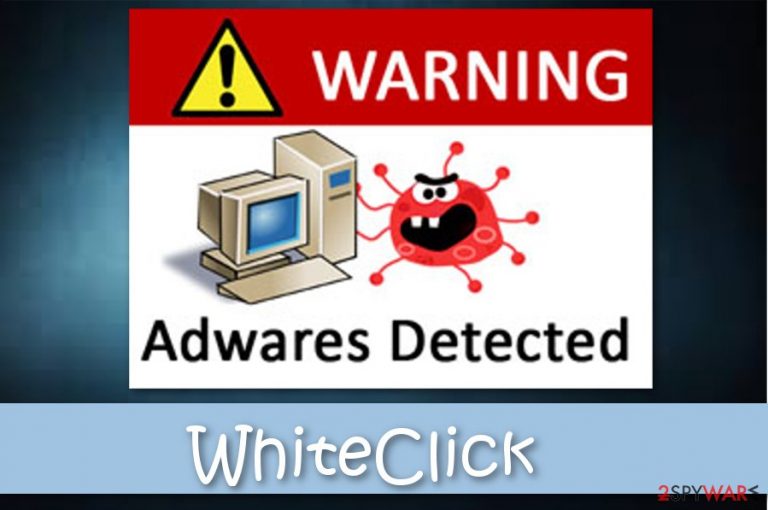
WhiteClick is a potentially unwanted program (PUP) which is programmed to install a controversial Toolbar on most frequently visited browsers, including Safari, Mozilla Firefox, Internet Explorer, and Google Chrome. WhiteClick Toolbar supposedly allows accessing popular sites faster. Although, according to the researchers, this adware program uses Ukrainian Google site to deliver search results. Even though such actions are not malicious, experts say that WhiteClick hijack might cause more damage than you think.
| Name | WhiteClick |
|---|---|
| Type | Adware |
| Also known as | White Click Toolbar |
| Danger level | Low, does not affect other computer systems |
| Purpose | To provide numerous ads and gain income from the pay-per-click method |
| Spreads by | Official downloading page, bundled freeware, various sites, and links |
| Deletion process | You can install FortectIntego in order to get rid of WhiteClick ads |
Be aware that WhiteClick adware gathers all browsing experience-related information. That includes the following:
- Pages you have visited;
- Keywords you typed via the search section; bookmarks;
- IP addresses;
- Etc.
This kind of activity allows the developers of an ad-supported program to deliver customized ads and attract users into clicking on them. In some cases, particular personal details can also be misused. In order to avoid such risk, remove WhiteClick from your browser as soon as you see it. We recommend using FortectIntego or any other similar anti-malware tool.
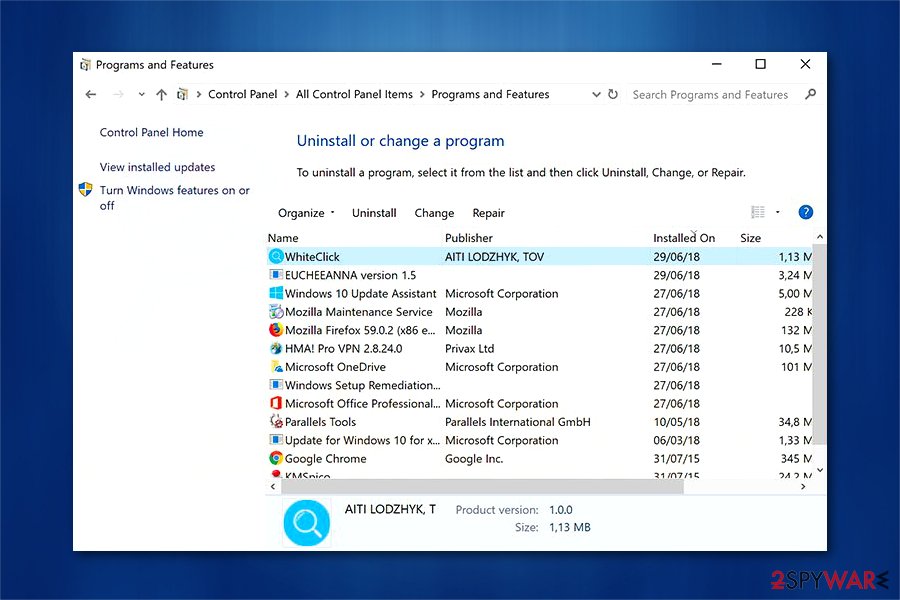
Moreover, this ad-supported program benefits from various intrusive ads[1]. It provides all kinds of advertisements: pop-ups, pop-unders, banners, coupons, etc. These ads might slow down your browsing activity increasingly. So, these annoying actions are just only another reason to do WhiteClick removal.
In addition, ads by WhiteClick might not only help gain revenue from the pay-per-click marketing method but might also lead you to various infective pages. There you can even get a more serious malware infection than annoying WhiteClick ads or WhiteClick Toolbar. Nevertheless, advertisements often occur to be misleading.
Ways to identify WhiteClick adware
Most users do not even know that they have downloaded WhiteClick installer. As developers of potentially unwanted programs (PUPs) manage to infiltrate their questionable applications stealthily, it might be difficult to identify and adware infection for regular computer users.
Usually, WhiteClick setup starts from either visiting a suspicious site or downloading freeware without attentively monitoring the installation procedure. As this adware can also take over most popular browsers, it begins altering browser settings to generate never-ending ads.
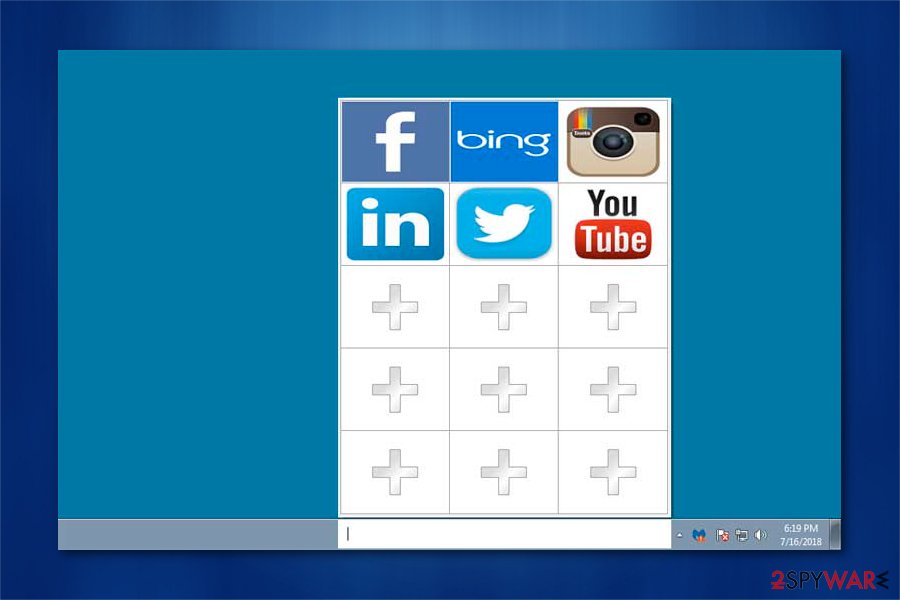
After WhiteClick download, users are also provided with WhiteClick Toolbar which allows browsing Ukrainian Google (https://www.google.com.ua/) or selecting specific pages to open in the default browser. If you have noticed that a suspicious Toolbar has occurred on your browser, you should start searching for WhiteClick removal tool immediately.
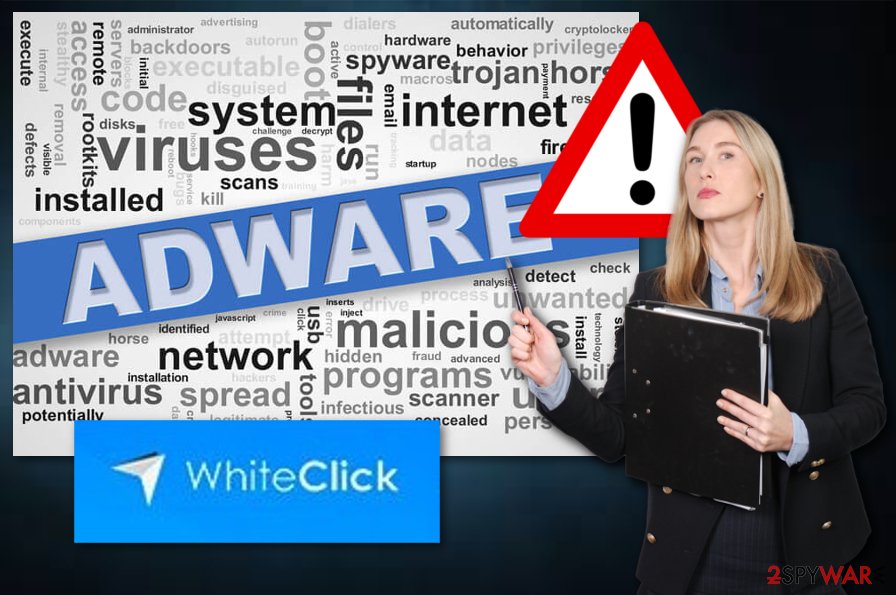
Additionally, there is a substantial risk that your computer is infected with the adware, if an excessive amount of advertisements are displayed during your browsing sessions. The easiest way to identify WhiteClick ads is by noticing the following marks:
- Ads by WhiteClick;
- Brought to you by WhiteClick;
- WhiteClick ads;
- Powered by WhiteClick.
Understanding adware distribution peculiarities can help you avoid the infection
It is common that users can download WhiteClick installer from its official website. However, further research revealed that developers not only promote their controversial products as useful but also pack them together with other third-party applications. This distribution method is regarded as bundling technique which helps install potentially unwanted programs bundled with freeware without user's knowledge[2].
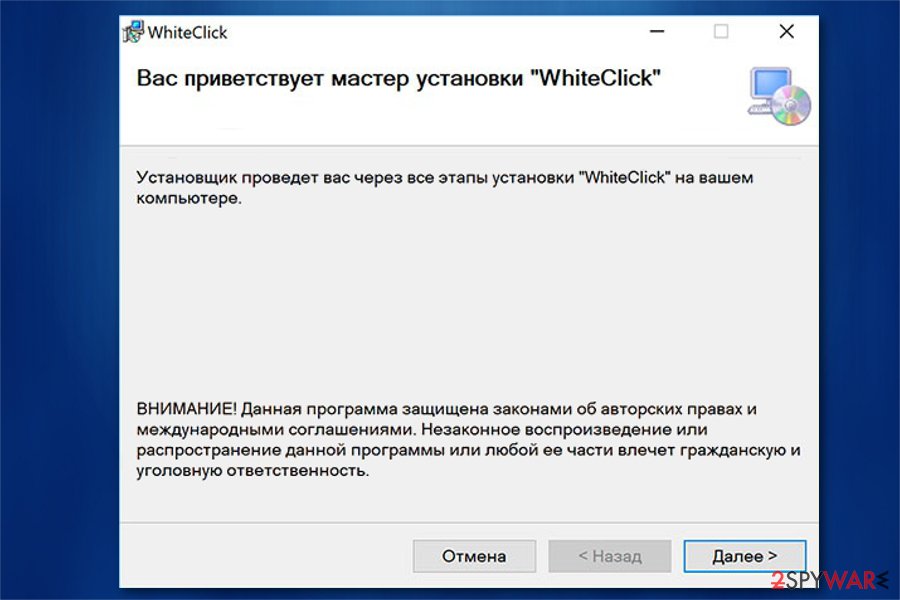
If you want to avoid ad-supported program's infiltration, follow these steps:
- Do not download freeware from secondary sources. Better look for the original downloading sites and get your software from there. However, if you manage to do downloads from third-party websites, go to the Custom/Advanced section and analyze all incoming downloads.
- Try not to skip downloading/installing steps. If you are in a rush – better do the installation next time than risk getting an adware-type program downloaded together.
- Be careful while browsing the web and visiting various sites as they might contain links which once clicked, will launch the ad-supported program and start its downloading process. If you already have encountered a suspicious-looking page, close it immediately and never return to it again.
- Install a professional security tool. An antivirus will scan your computer system and guide you through the removal process if some threats are found.
WhiteClick uninstall guide is suitable for WhiteClick Toolbar removal as well
It is vital to mention that WhiteClick virus term is merely used by frustrated computer users who can't get rid of WhiteClick easily. This term is not accurate as adware infections are categorized as potentially unwanted programs (PUPs) rather than viruses by IT experts[3]. Although, our experts have useful tips to help you perform WhiteClick uninstall. Note, that these steps are suitable for WhiteClick Toolbar removal as well.
You can remove WhiteClick either manually or automatically. However, keep in mind that manual WhiteClick removal requires you to identify, locate and delete all components which are related to the adware. If you think that you are not experienced enough, try following the guidelines presented at the end of this article.
Otherwise, you can remove WhiteClick Toolbar more quickly by installing an anti-malware tool. The ad-supported program elimination will take only up to a few minutes. After the process is fully done, we recommend refreshing your computer to ensure that no dubious content is left hiding.
You may remove virus damage with a help of FortectIntego. SpyHunter 5Combo Cleaner and Malwarebytes are recommended to detect potentially unwanted programs and viruses with all their files and registry entries that are related to them.
Getting rid of WhiteClick. Follow these steps
Uninstall from Windows
If WhiteClick has invaded into your Windows OS, please continue reading and look through these guidelines:
Instructions for Windows 10/8 machines:
- Enter Control Panel into Windows search box and hit Enter or click on the search result.
- Under Programs, select Uninstall a program.

- From the list, find the entry of the suspicious program.
- Right-click on the application and select Uninstall.
- If User Account Control shows up, click Yes.
- Wait till uninstallation process is complete and click OK.

If you are Windows 7/XP user, proceed with the following instructions:
- Click on Windows Start > Control Panel located on the right pane (if you are Windows XP user, click on Add/Remove Programs).
- In Control Panel, select Programs > Uninstall a program.

- Pick the unwanted application by clicking on it once.
- At the top, click Uninstall/Change.
- In the confirmation prompt, pick Yes.
- Click OK once the removal process is finished.
Delete from macOS
Remove items from Applications folder:
- From the menu bar, select Go > Applications.
- In the Applications folder, look for all related entries.
- Click on the app and drag it to Trash (or right-click and pick Move to Trash)

To fully remove an unwanted app, you need to access Application Support, LaunchAgents, and LaunchDaemons folders and delete relevant files:
- Select Go > Go to Folder.
- Enter /Library/Application Support and click Go or press Enter.
- In the Application Support folder, look for any dubious entries and then delete them.
- Now enter /Library/LaunchAgents and /Library/LaunchDaemons folders the same way and terminate all the related .plist files.

Remove from Microsoft Edge
Delete unwanted extensions from MS Edge:
- Select Menu (three horizontal dots at the top-right of the browser window) and pick Extensions.
- From the list, pick the extension and click on the Gear icon.
- Click on Uninstall at the bottom.

Clear cookies and other browser data:
- Click on the Menu (three horizontal dots at the top-right of the browser window) and select Privacy & security.
- Under Clear browsing data, pick Choose what to clear.
- Select everything (apart from passwords, although you might want to include Media licenses as well, if applicable) and click on Clear.

Restore new tab and homepage settings:
- Click the menu icon and choose Settings.
- Then find On startup section.
- Click Disable if you found any suspicious domain.
Reset MS Edge if the above steps did not work:
- Press on Ctrl + Shift + Esc to open Task Manager.
- Click on More details arrow at the bottom of the window.
- Select Details tab.
- Now scroll down and locate every entry with Microsoft Edge name in it. Right-click on each of them and select End Task to stop MS Edge from running.

If this solution failed to help you, you need to use an advanced Edge reset method. Note that you need to backup your data before proceeding.
- Find the following folder on your computer: C:\\Users\\%username%\\AppData\\Local\\Packages\\Microsoft.MicrosoftEdge_8wekyb3d8bbwe.
- Press Ctrl + A on your keyboard to select all folders.
- Right-click on them and pick Delete

- Now right-click on the Start button and pick Windows PowerShell (Admin).
- When the new window opens, copy and paste the following command, and then press Enter:
Get-AppXPackage -AllUsers -Name Microsoft.MicrosoftEdge | Foreach {Add-AppxPackage -DisableDevelopmentMode -Register “$($_.InstallLocation)\\AppXManifest.xml” -Verbose

Instructions for Chromium-based Edge
Delete extensions from MS Edge (Chromium):
- Open Edge and click select Settings > Extensions.
- Delete unwanted extensions by clicking Remove.

Clear cache and site data:
- Click on Menu and go to Settings.
- Select Privacy, search and services.
- Under Clear browsing data, pick Choose what to clear.
- Under Time range, pick All time.
- Select Clear now.

Reset Chromium-based MS Edge:
- Click on Menu and select Settings.
- On the left side, pick Reset settings.
- Select Restore settings to their default values.
- Confirm with Reset.

Remove from Mozilla Firefox (FF)
Remove dangerous extensions:
- Open Mozilla Firefox browser and click on the Menu (three horizontal lines at the top-right of the window).
- Select Add-ons.
- In here, select unwanted plugin and click Remove.

Reset the homepage:
- Click three horizontal lines at the top right corner to open the menu.
- Choose Options.
- Under Home options, enter your preferred site that will open every time you newly open the Mozilla Firefox.
Clear cookies and site data:
- Click Menu and pick Settings.
- Go to Privacy & Security section.
- Scroll down to locate Cookies and Site Data.
- Click on Clear Data…
- Select Cookies and Site Data, as well as Cached Web Content and press Clear.

Reset Mozilla Firefox
If clearing the browser as explained above did not help, reset Mozilla Firefox:
- Open Mozilla Firefox browser and click the Menu.
- Go to Help and then choose Troubleshooting Information.

- Under Give Firefox a tune up section, click on Refresh Firefox…
- Once the pop-up shows up, confirm the action by pressing on Refresh Firefox.

Remove from Google Chrome
If you want to get rid of the adware infection from Google Chrome, read the text below:
Delete malicious extensions from Google Chrome:
- Open Google Chrome, click on the Menu (three vertical dots at the top-right corner) and select More tools > Extensions.
- In the newly opened window, you will see all the installed extensions. Uninstall all the suspicious plugins that might be related to the unwanted program by clicking Remove.

Clear cache and web data from Chrome:
- Click on Menu and pick Settings.
- Under Privacy and security, select Clear browsing data.
- Select Browsing history, Cookies and other site data, as well as Cached images and files.
- Click Clear data.

Change your homepage:
- Click menu and choose Settings.
- Look for a suspicious site in the On startup section.
- Click on Open a specific or set of pages and click on three dots to find the Remove option.
Reset Google Chrome:
If the previous methods did not help you, reset Google Chrome to eliminate all the unwanted components:
- Click on Menu and select Settings.
- In the Settings, scroll down and click Advanced.
- Scroll down and locate Reset and clean up section.
- Now click Restore settings to their original defaults.
- Confirm with Reset settings.

Delete from Safari
Remove unwanted extensions from Safari:
- Click Safari > Preferences…
- In the new window, pick Extensions.
- Select the unwanted extension and select Uninstall.

Clear cookies and other website data from Safari:
- Click Safari > Clear History…
- From the drop-down menu under Clear, pick all history.
- Confirm with Clear History.

Reset Safari if the above-mentioned steps did not help you:
- Click Safari > Preferences…
- Go to Advanced tab.
- Tick the Show Develop menu in menu bar.
- From the menu bar, click Develop, and then select Empty Caches.

After uninstalling this potentially unwanted program (PUP) and fixing each of your web browsers, we recommend you to scan your PC system with a reputable anti-spyware. This will help you to get rid of WhiteClick registry traces and will also identify related parasites or possible malware infections on your computer. For that you can use our top-rated malware remover: FortectIntego, SpyHunter 5Combo Cleaner or Malwarebytes.
How to prevent from getting adware
Choose a proper web browser and improve your safety with a VPN tool
Online spying has got momentum in recent years and people are getting more and more interested in how to protect their privacy online. One of the basic means to add a layer of security – choose the most private and secure web browser. Although web browsers can't grant full privacy protection and security, some of them are much better at sandboxing, HTTPS upgrading, active content blocking, tracking blocking, phishing protection, and similar privacy-oriented features. However, if you want true anonymity, we suggest you employ a powerful Private Internet Access VPN – it can encrypt all the traffic that comes and goes out of your computer, preventing tracking completely.
Lost your files? Use data recovery software
While some files located on any computer are replaceable or useless, others can be extremely valuable. Family photos, work documents, school projects – these are types of files that we don't want to lose. Unfortunately, there are many ways how unexpected data loss can occur: power cuts, Blue Screen of Death errors, hardware failures, crypto-malware attack, or even accidental deletion.
To ensure that all the files remain intact, you should prepare regular data backups. You can choose cloud-based or physical copies you could restore from later in case of a disaster. If your backups were lost as well or you never bothered to prepare any, Data Recovery Pro can be your only hope to retrieve your invaluable files.
- ^ Adware. Wikipedia. The free encyclopedia.
- ^ Bundled Software. Techopedia. Where Information Technology and Business Meet.
- ^ Virsuler Info TR. Virusler. Security and Spyware News.
